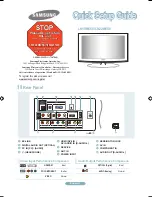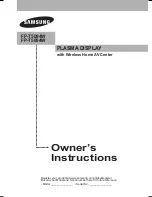
Alignments
8.
8.
Alignments
Index of this chapter:
8.1 General Alignment Conditions
8.2 Hardware Alignments
8.3 Software Alignments
8.4 Option Settings
Note:
Figures below can deviate slightly from the actual
situation, due to the different set executions.
General:
The Service Default Mode (SDM) and Service
Alignment Mode (SAM) are described in chapter 5. Menu
navigation is done with the CURSOR UP, DOWN, LEFT or
RIGHT keys of the remote control transmitter.
8.1
General Alignment Conditions
Perform all electrical adjustments under the following
conditions:
•
Power supply voltage (depends on region):
–
AP-NTSC: 120 V
AC
or 230 V
AC
/ 50 Hz (
±
10%).
–
AP-PAL-multi: 120 - 230 V
AC
/ 50 Hz (
±
10%).
–
EU: 230 V
AC
/ 50 Hz (
±
10%).
–
LATAM-NTSC: 120 - 230 V
AC
/ 50 Hz (
±
10%).
–
US: 120 V
AC
/ 60 Hz (
±
10%).
•
Connect the set to the mains via an isolation transformer
with low internal resistance.
•
Allow the set to warm up for approximately 15 minutes.
•
Measure voltages and waveforms in relation to correct
ground (e.g. measure audio signals in relation to
AUDIO_GND).
Caution:
It is not allowed to use heatsinks as ground.
•
Test probe: Ri > 10 Mohm, Ci < 20 pF.
•
Use an isolated trimmer/screwdriver to perform
alignments.
8.2
Hardware Alignments
There are no hardware alignments foreseen for this chassis,
but below find an overview of the most important DC voltages
on the SSB. These can be used for checking proper functioning
of the DC/DC converters.
8.3
Software Alignments
With the software alignments of the Service Alignment Mode
(SAM) the Tuner and RGB settings can be aligned.
To store the data: Use the RC button “Menu” to switch to the
main menu and next, switch to “Stand-by” mode.
8.3.1
Tuner Adjustment (RF AGC Take Over Point)
Purpose:
To keep the tuner output signal constant as the input
signal amplitude varies.
This chassis comes with the UV13x6(x) tuner. No alignment is
necessary, as the AGC alignment is done automatically
(standard value: “15”). However in case of problems use the
following method (use multi meter and RF generator):
•
Apply a vision IF carrier of 38.9 (China: 38.0) MHz (105
dB
μ
V = 178 mVrms) to test point F143 (input via 50 ohm
coaxial cable terminated with an RC network of series
10 nF with 120 ohm to ground).
•
Measure voltage on test point F116.
•
Adjust AGC (via SAM menu: TUNER -> AGC), until voltage
on test point F116 is 3.3 +0.5/-1.0 V.
•
Store settings and quit SAM.
8.3.2
RGB Alignment
Before alignment, choose “TV MENU” -> “Picture” and set:
•
“Brightness” to “50”.
•
“Colour” to “50”.
•
“Contrast” to “100”.
White Tone Alignment:
•
Activate SAM.
•
Select “RGB Align.” -> “White Tone” and choose a colour
temperature.
•
Use a 100% white screen as input signal and set the
following values:
–
All “White point” values initial to “256”.
–
All “BlackL Offset” values to “0”.
In case you have a colour analyser:
•
Measure with a calibrated (phosphor- independent) colour
analyser (e.g. Minolta CA-210) in the centre of the screen.
Consequently, the measurement needs to be done in a
dark environment.
•
Adjust the correct x, y coordinates (while holding one of the
White point registers R, G or B on “256”) by means of
decreasing the value of one or two other white points to the
correct x, y coordinates (see table “White D alignment
values”). Tolerance: dx:
±
0.004, dy:
±
0.004.
•
Repeat this step for the other colour Temperatures that
need to be aligned.
•
When finished return to the SAM root menu and press
STANDBY on the RC to store the aligned values to the
NVM.
Table 8-1 White D alignment values
If you do
not
have a colour analyser, you can use the default
values. This is the next best solution. The default values are
average values coming from production (statistics).
Description
Test
Point
Specifications
(V)
Diagram
Min. Typ. Max.
+12V_DISP
FP12
11.4 12.0 12.6 B01A_DC-DC
+VTUN
FP11
30
33
36
B01A_DC-DC
+3V3_STBY
FP10
3.20 3.30 3.40 B01A_DC-DC
+3V3+SW
FP20
3.13 3.3
3.46 B01A_DC-DC
+1V2_SW
FP24
1.18 1.25 1.31 B01A_DC-DC
+5V_SW
FQ05
4.85 5.10 5.35 B01B_DC-DC
+1V8_SW
FQ06
1.72 1.82 5.25 B01B_DC-DC
+2V5_SW
FQ03
2.38 2.5
2.62 B01B_DC-DC
+5V_IF
F129
4.75 5
5.25 B02_TUNER_IF
+5VS
F131
4.75 5
5.25 B02_TUNER_IF
+5V_TUN
F146
4.75 5
5.25 B02_TUNER_IF
+1V2_ADC
FC04
1.14 1.2
1.26 B04A_TRIDENT
+1V2_PLL
FC05
1.14 1.2
1.26 B04A_TRIDENT
+1V2_CORE
FC06
1.14 1.2
1.26 B04A_TRIDENT
+2V5_VDDM
Q
FD01
2.38 2.5
2.62 B04B_DDR
+VDISP
FR10
11.4 12.0 12.6 B04E_LVDS
+8V
F401
7.60 8.00 8.40 B05A_AUDIOPR
OCESSOR
Value
Cool (11000 K)
Normal (9000
K)
Warm (6500 K)
x
0.278
0.289
0.314
y
0.278
0.291
0.319
Содержание 47PFL5403
Страница 26: ...Service Modes Error Codes and Fault Finding EN 26 LC8 2A LA 5 Personal Notes E_06532_012 eps 131004 ...
Страница 43: ...Circuit Diagrams and PWB Layouts 43 LC8 2A LA 7 Layout Main Power Supply 42 Top Side H_16750_070 eps 110108 ...
Страница 44: ...44 LC8 2A LA 7 Circuit Diagrams and PWB Layouts Layout Main Power Supply 42 Bottom Side H_16750_071 eps 110108 ...
Страница 92: ...92 LC8 2A LA 7 Circuit Diagrams and PWB Layouts Personal Notes E_06532_013 eps 131004 ...
















































